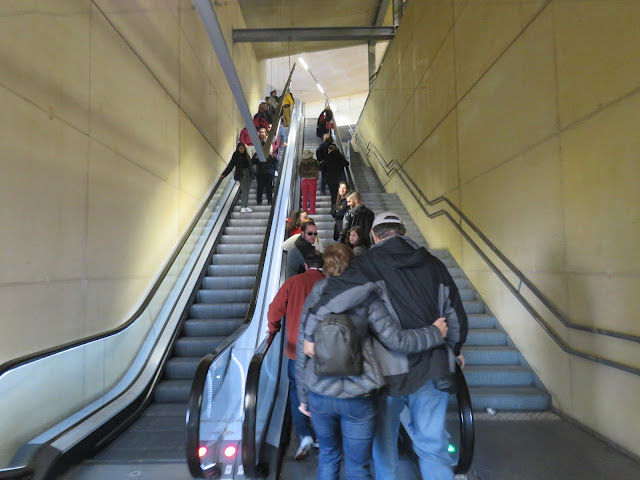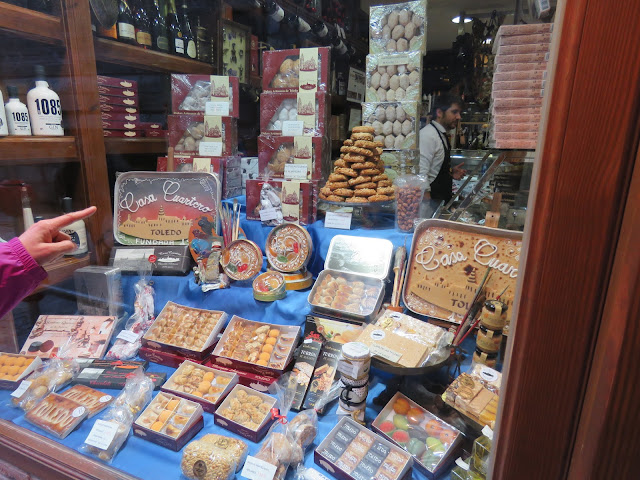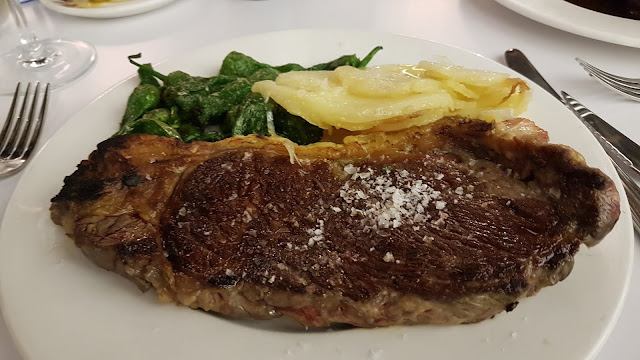Nov 14 Madrid on our own
Nov 15 Madrid on our own
Nov 16 Madrid on our own until Welcome Dinner
Nov 17 Madrid City Tour and Prado Museum
Week 1 Recap
Italics are Gate 1 tour descriptions.
Optional: Half Day Toledo (PM) ADDED
Join the optional afternoon tour to Toledo. Enjoy a walking tour among the most famous monuments.
Toledo is a "Museum City" of great artistic beauty. Former capital of Spain and one of the oldest cities in Europe, Toledo has magnificent examples of architecture from different periods, making it one of the leading artistic cities of the country. In Toledo visit the most famous monuments, such as St. Tome Church, which houses El Greco's 'The Burial of Count Orgaz" and the Santa Maria la Blanca Synagogue. Also admire its famous hand-crafted work, the "Damasquinado."
Approximate tour duration is 5 hours.
Toledo is the capital of the province of Toledo and the autonomous community of Castile–La Mancha. Toledo was declared a World Heritage Site by UNESCO in 1986 for its extensive monumental and cultural heritage.
And it easy to see why as we enter the town.
Dramatically sited atop a gorge overlooking the Río Tajo, it was known as the ‘city of three cultures’ in the Middle Ages, a place where – legend has it – Christian, Muslim and Jewish communities peacefully coexisted. Toledo is known as the "Imperial City" for having been the main venue of the court of Charles V, Holy Roman Emperor.
We drive to a spot overlooking the city for some dramatic views.
As we step off the bus we are greeted by this busker.
The walled medieval city of Toledo is an important tourist destination with limited parking and poor access for all those people. The narrow cobbled streets are simply not big enough to accommodate all the pedestrians and vehicles necessary to support the urban center, not to mention how the vibrations and pollution damaged the ancient buildings.
The innovative solution in 2001 was to design a series of escalators and covered walkways from an underground garage into and through the ancient walls. Instead of one very long escalator, the architects planned a total of 6 differently angled ones protected from the elements and taking advantage of the views. Their international award-winning project won the Elevator World – Project of the Year Award for 2002/2003.
Up at the top of the escalator walls we have this view.
Catedral de Toledo was not open to visitors when we arrived.
Toledo's illustrious main church ranks among the top 10 cathedrals in Spain. An impressive example of medieval Gothic architecture, its enormous interior is full of the classic characteristics of the style, rose windows, flying buttresses, ribbed vaults and pointed arches among them. The cathedral’s sacristy is a veritable art gallery of old masters, with works by Velázquez, Goya and – of course – El Greco.
How I wish we had been able to visit.
Across from the Cathedral is the Town Hall (Ayuntamiento), a beautiful building with a small park in front, planted with colorful flowers. The Town Hall building was designed by the famous architect Juan Herrera, who designed El Escorial. Gomez Enrique started its construction in 1575, using the plans of Herrera. Herrera's design included a main facade with a severe face. The base used cut stone and had nine round arches. Nicolas de Vergara (El Mozo) and Juan Bautista Monegro worked on the first floor, while Jorge Manuel Theotocopulos (the son of El Greco) worked on the second floor at the beginning of the 17th century. Ardemans was the architect for the Baroque towers that used slate, and this was done in 1703. The triangular front has the coat of arms of the city.
Around town.
That's Anne Bob and me dragging up the rear.
For a bathroom break we were allowed to use this shop's facilities. With the idea that we could watch the workmen and ideally buy something.
The manufacture of swords in the city of Toledo goes back to Roman times, but it was under Moorish rule and during the Reconquista that Toledo and its guild of sword-makers played a key role. Between the 15th and 17th centuries the Toledo sword-making industry enjoyed a great boom, to the point where its products came to be regarded as the best in Europe. In the late 17th and early 18th century production began to decline, prompting the creation of the Royal Arms Factory in 1761 by order of King Carlos III.
While waiting for the others we found this charming performer.
Visi the St. Tome Church with its El Greco masterpiece
We line up to enter St. Tome.
The Iglesia de Santo Tomé was founded after the reconquest of this city by King Alfonso VI of León. It appears quoted in the 12th century, as constructed on the site of an old mosque of the 11th century. This mosque, together with other mosques in the city, were used as Christian churches without major changes, since in the taking of the city there was no destruction of buildings.
However, at the beginning of the 14th century, being in a ruinous state was totally rebuilt in charge of Gonzalo Ruiz de Toledo, Lord of Orgaz and the old minaret of the mosque was transformed into a bell tower in Mudéjar style. Its fame is mainly due to the fact that it contains the painting The Burial of the Count of Orgaz by El Greco, which can be seen by accessing the back of church.
Again no photos allowed.
Some dates we learned as we visited mosques. churches and synagogues and will remain in my memory.
711 - in 711 the Islamic Arab and Moors of Berber descent in northern Africa crossed the Strait of Gibraltar onto the Iberian Peninsula, and in a series of raids they conquered Visigothic Christian Hispania. Their general, Tariq ibn Ziyad, brought most of Iberia under Islamic rule in an eight-year campaign.
In 1492, Jews and Muslims were officially expelled from Spain, forced either to convert or to flee into exile. Historically, Spain was home to significant Jewish and Muslim populations. However, centuries of persecution of these groups in the country culminated in the complete removal of these peoples, and for the Jews especially, their culture. For Spain, a nation formed under “Catholic Monarchs,” a Catholic identity has long been important. Even modern secularism and religious diversity are extremely new concepts for this country, which had a devout Catholic dictator until the mid-1970s. Under Franco’s rule, Roman Catholicism was the only religion with legal status, and church and state were deeply intertwined. Only after Franco’s death did liberalization movements lead to modernizations like the legalization of civil marriages and abortion, which separated church and state and paved the way for a more secular state.
Each intersection of the Jewish Quarter has these little tiles on the street containing some Jewish symbol.
Santa Maria la Blanca Synagogue with its beautiful Moorish architecture, the oldest synagogue in Europe still standing.
The Synagogue of Santa María la Blanca is a museum and former synagogue in Toledo, Spain. Erected in 1180, according to an inscription on a beam, it is disputably considered the oldest synagogue building in Europe still standing. It is now owned and preserved by the Catholic Church. Its stylistic and cultural classification is unique among surviving buildings as it was constructed under the Christian Kingdom of Castile by Islamic architects for Jewish use. It is considered a symbol of the cooperation that existed among the three cultures that populated the Iberian Peninsula during the Middle Ages
So why is it so hard for all of us to live together these days?
The bus is waiting on the other side of the bridge so we don't go back on our steps and down the escalators.
The Saint Martin’s Bridge (Puente de San Martín) dates back to 14th century. The Roman-era Alcántara Bridge (Puente de Alcántara) dating back to 104 AD, rebuilt in 866 AD and repaired several times more recently.
The Saint Martin’s Bridge and Alcántara Bridge both span the Tagus River (Río Tajo) as it winds through Toledo on its journey to Lisbon, Portugal before reaching the Atlantic Ocean.
I found this Toledo video that is interesting.
Toledo is well-known for its marzipan. The guide bought a box for us to sample on the drive back to Madrid.
It is almost 8 PM when we get back to the hotel and we take a taxi to Plaza Mayor for dinner.
The historic wrought-iron-and-glass Mercado de San Miguel, just off Plaza Mayor, has become one of the liveliest culinary spots in the city. So much so that it was packed on a Saturday night.
We wandered around, getting jostled at every turn, and wished we were here for a few days more to come back at a less busy time.
Alongside stalls selling fresh produce are tapas bars offering a wide variety of treats such as gambas al ajillo (garlic prawns) and banderillas (small skewers of olives, cucumbers, peppers and pickled onions).
You can have an aperitif of the house vermouth (on draft, €1.50), or grab a caña (small beer, €2) or a glass of rioja (from €3) from any of several wine kiosks.
We head back to Plaza Mayor and find a spot inside in a restaurant. Soportal translates as porch.
John's steak
Lamb shoulder. I loved these peppers.
PADRÓN PEPPERS
Pimientos de Padrón are small, bright green peppers that come from the municipality of Padrón in Galicia, in the northwest part of Spain. They’re usually mild in flavor, with low levels of capsaicin.
The bus is waiting on the other side of the bridge so we don't go back on our steps and down the escalators.
The Saint Martin’s Bridge (Puente de San Martín) dates back to 14th century. The Roman-era Alcántara Bridge (Puente de Alcántara) dating back to 104 AD, rebuilt in 866 AD and repaired several times more recently.
The Saint Martin’s Bridge and Alcántara Bridge both span the Tagus River (Río Tajo) as it winds through Toledo on its journey to Lisbon, Portugal before reaching the Atlantic Ocean.
Same couple.
I found this Toledo video that is interesting.
Toledo is well-known for its marzipan. The guide bought a box for us to sample on the drive back to Madrid.
Tonight, opt to explore Madrid’s fabulous restaurants and non-stop nightlife
Dinner on your own
It is almost 8 PM when we get back to the hotel and we take a taxi to Plaza Mayor for dinner.
The historic wrought-iron-and-glass Mercado de San Miguel, just off Plaza Mayor, has become one of the liveliest culinary spots in the city. So much so that it was packed on a Saturday night.
We wandered around, getting jostled at every turn, and wished we were here for a few days more to come back at a less busy time.
Alongside stalls selling fresh produce are tapas bars offering a wide variety of treats such as gambas al ajillo (garlic prawns) and banderillas (small skewers of olives, cucumbers, peppers and pickled onions).
We head back to Plaza Mayor and find a spot inside in a restaurant. Soportal translates as porch.
John's steak
Lamb shoulder. I loved these peppers.
PADRÓN PEPPERS
Pimientos de Padrón are small, bright green peppers that come from the municipality of Padrón in Galicia, in the northwest part of Spain. They’re usually mild in flavor, with low levels of capsaicin.
Ingredients
300 grams of Padrón peppers (about 2 cups)
50 ml extra virgin olive oil
Flaky sea salt
Instructions
Rinse and dry the peppers.
Heat the olive oil in a pan at high heat until it starts smoking lightly.
Add the peppers and cook, tossing occasionally, until the skin starts to blister and soften.
Remove the peppers and place them on a plate.
Sprinkle generously with sea salt.
300 grams of Padrón peppers (about 2 cups)
50 ml extra virgin olive oil
Flaky sea salt
Instructions
Rinse and dry the peppers.
Heat the olive oil in a pan at high heat until it starts smoking lightly.
Add the peppers and cook, tossing occasionally, until the skin starts to blister and soften.
Remove the peppers and place them on a plate.
Sprinkle generously with sea salt.





































































Andrew, I deleted your comment by mistake, it's only 7 AMM here. I will have the crema catalana but you can have the olives, I hate them.
ReplyDeleteMaginficent views!
ReplyDelete